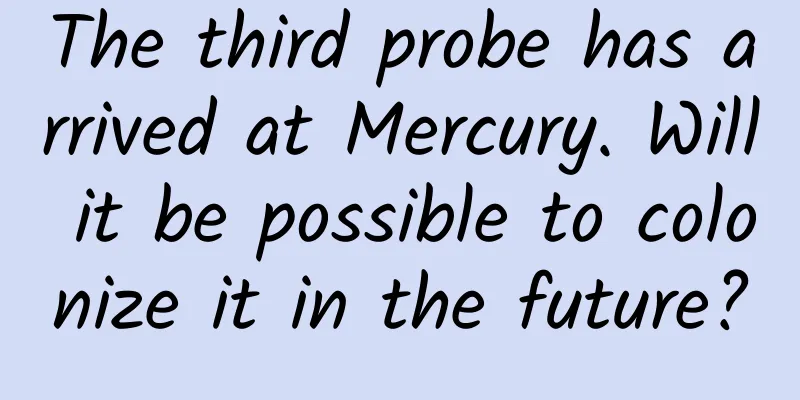The third probe has arrived at Mercury. Will it be possible to colonize it in the future?

|
Mercury is the planet closest to the Sun, with an average distance of 57.9 million kilometers from the Sun. It is also the smallest planet in the solar system, with a radius of 2,440 kilometers and a mass of only about 5% of the Earth, about 3.3*10^23 kilograms. Due to its proximity to the Sun, it orbits the Sun very quickly, with only about 88 days a year (Earth days, the same below), but it rotates very slowly, with one day equivalent to 58.65 Earth days. So there, just a little over one day is a year. Humans have launched more than 120 planetary and interplanetary probes so far, but only two have been to Mercury, namely the United States' Mercury 10 and Messenger. Mercury 10 was launched in 1973, and Messenger was launched in 2004. Only Messenger was specifically designed to explore Mercury. Just two days ago, the BepiColombo Mercury probe sent back a photo of Mercury. This is the second photo taken by the second probe specially sent by humans to explore Mercury. This probe was launched in 2018, 14 years after the "MESSENGER" and is now on its journey to enter Mercury's orbit. Now let's take a look at the BepiColombo detector/ BepiColombo is the nickname of Italian scientist Giuseppe Colombo, who is famous for first proposing the use of planetary gravity slingshot effect. The Mercury probe is named after him in his honor. This mission started in the 1990s. After 21 years of development and $1.8 billion in construction, the Mercury probe was launched on October 28, 2018 from the Kourou Space Center in French Guiana. The BepiColombo probe is actually two probes glued together, one of which belongs to the European Space Agency and is the Mercury Planetary Orbiter MPO; the other belongs to the Japanese Aerospace Exploration Agency and is the Mercury Magnetospheric Orbiter MMO. On the way to Mercury, they travel together to cope with the gravitational effects of the journey. After reaching Mercury's orbit, they will separate and conduct different projects on Mercury at different orbital altitudes. BepiColombo is actually composed of three modules, which will automatically separate after reaching Mercury. MPO is mainly responsible for detecting the surface and internal structure of Mercury, MMO is mainly responsible for detecting Mercury's magnetic field and its interaction with the solar wind, and the other module is responsible for transporting them to their destination, called MTM. The main equipment and instruments carried by the MPO detector are: laser altimeter, Italian spring accelerometer, magnetometer, thermal infrared spectrometer, gamma ray and neutron spectrometer, imaging X-ray spectrometer, outer atmosphere detection ultraviolet spectrometer, outer atmosphere neutron emission and replenishment research equipment, spectrometer plotter, solar intensity X-ray spectrometer, etc. The main equipment and instruments carried by the MMO detector include: magnetometer, plasma particle experimental equipment, sodium atmosphere spectrometer, dust monitor, etc. This group of probes will officially enter Mercury's orbit to carry out their mission in 2025. By then, MPO will operate in an elliptical orbit of 400*1500 kilometers, MMO will operate in an elliptical orbit of 400*12000 kilometers, and after MTM sends the two "passengers" into orbit, it will have completed its mission. Whether it drifts or crashes depends on the intentions of the control engineers. So why does the probe launched in 2018 have to wait until 2025 to enter Mercury's orbit? Moreover, the first photo was sent back on October 1, 2021, and the second photo was sent back two days ago, and the closest distance to Mercury was only 200 kilometers. Why hasn't it entered Mercury's orbit yet? How can a probe reach Mercury? In recent years, people's attention has been more focused on the outer planets of the solar system, such as Mars, Jupiter, Saturn, Uranus, Neptune, etc. The spacecraft exploring these celestial bodies fly away from the sun, and due to the pull of the sun's gravity, they will become slower and slower, so they have to constantly accelerate in order to fly faster and farther. Last glimpse of BepiColombo probe as it leaves Earth However, it is impossible for any probe to carry a lot of fuel and rely on fuel to increase its speed. Therefore, scientists cleverly use the slingshot effect of planetary gravity to increase the speed of the probe when passing by a large planet at a certain angle. Voyager 1 and 2 in the last century and New Horizons in this century all reached the speed to fly out of the solar system in this way. Some people may think that a probe heading to Mercury will not be slowed down by the sun's gravity and will reach its destination more easily. In fact, it is more difficult for a probe flying to a planet inward from the Earth because it will be pulled faster and faster by the sun's gravity. If it cannot stop, it will not be able to stay within the planet's gravity range. It will "whoosh" past and never come back, either circling the sun or crashing into the sun and burning up. Mercury is a planet with a very small mass, so its gravity is very small. At an altitude of 400-500 kilometers above the surface of Mercury, the orbital speed is less than 3km/s. When launching, to leave the Earth's gravity and fly to other planets, the speed must reach at least the second cosmic speed, which is 11.2km/s. Once it flies out of the Earth's gravitational circle, it will be pulled faster and faster by the gravity of the sun. To reach the orbital speed when reaching Mercury, it must constantly "brake". BepiColombo captured this image as it flew past Venus If the probe wants to brake by itself, it will need a lot of fuel for reverse thrust. It is impossible to carry so much fuel. What should we do? Or use the gravitational slingshot effect of the planet to help brake. Some people may think that the gravitational slingshot effect can only increase speed, how can it brake? Planetary gravity is so amazing that it can be used to speed up or brake. It just requires precise control of the angle of intersection with the planet. Italian scientist Giuseppe Colombo first introduced the use of gravitational slingshot effect in 1974, when it was applied to the Mariner 10 probe that first went to Mercury. The BepiColombo probe will use the gravity slingshot effect to "brake" 9 times before entering Mercury's orbit. The planets that provide "brakes" are: Earth 1 time, Venus 2 times, and Mercury 6 times. In fact, when the Mercury probe first arrived at Mercury on October 1 last year, it was already the third braking process. That is, it used the Earth's gravity to brake for the first time when leaving the Earth, used Venus's gravity to brake for the second time when passing by Venus, and braked for the third time after arriving at Mercury. Afterwards, the probe returned to Venus and braked once more using the gravity of Venus, thus completing the braking missions of the first brake on Earth and the second brake on Venus. Now it has braked for the fifth time at Mercury. After that, it will not return to Venus, but will circle around Mercury in a large elliptical circle, braking four more times using the gravity of Mercury. Judging from the entire flight trajectory, BepiColombo is actually flying in a gradually shrinking spiral circle around the sun. This circle will take 7.2 years, with a total flight distance of 9 billion kilometers. The farthest point from the earth is 240 million kilometers, and the maximum flight speed can reach 60km/s. The above animated image is a schematic diagram of the flight trajectory of the BepiColombo Mercury probe: pink represents the flight trajectory of the BepiColombo probe, blue represents the Earth's orbit, light blue represents the Venus orbit, green represents the Mercury orbit, and the yellow dot represents the sun. Therefore, it is easy to see how difficult it is to reach Mercury. After all this trouble, if all goes well, BepiColombo will not be able to enter orbit until December 5, 2025, and will not be able to officially start exploration until 2026. The significance of Mercury exploration/ Mercury has almost no atmosphere. Under the scorching heat of the sun, the temperature on the side facing the sun reaches a maximum of 429°C, while the temperature on the side facing away from the sun reaches a minimum of -190°C. This is also a difficulty in Mercury exploration, as the probe must withstand the test of high temperatures of hundreds of degrees Celsius. Mercury's surface is a bit like the moon, full of craters, and has two extremes of hot and cold. It is a long-dead planet that seems to have no value to humans. But after detection by ground-based telescopes and probes, scientists have discovered that this smallest planet is not simple and has many unsolved mysteries. First, Mariner 10 detected Mercury's magnetic field, and this magnetic field, like the Earth's magnetic field, deflects the solar wind. The Earth's magnetic field is formed due to the different rotation speeds of its liquid core and mantle and crust. Why does Mercury, a planet once thought to be dead, have a magnetic field? Second, data from the MESSENGER probe shows that there is a large amount of water ice in the craters in the polar regions of Mercury. The weight of this water ice is as much as trillions of tons. Where does this water ice come from? Third, Mercury has a density of 5.427 g/cm^3, second only to Earth in the solar system. Research suggests that Mercury's core accounts for 42% of its volume and 60% of its total mass, so it is a huge iron core with an iron content of 200 trillion tons, enough for humans to mine for 240 billion years. There are also some materials and gases on the surface of Mercury that overflow from the interior, resulting in some strange caves on the surface. Could it be that Mercury still has geological activities and is not dead? The surface of Mercury is similar to the moon, but it looks dark under the sun, with an albedo of only 0.088, which is only one-eighth of the moon's albedo of 0.136. What is the reason for this? In short, among the eight planets in the solar system, especially the five planets closest to the Earth, Mercury is the least understood by humans. The BepiColombo probe launched this time will conduct a more comprehensive survey of Mercury than any previous one. Clarifying the structure of Mercury may be of great significance to the future of mankind. In order to save humanity from extinction, the call for human migration to other planets is growing, and Mars has become the first candidate. The successful development of Iron Man Musk's giant starship and his series of research and development around Mars have made the dream of human migration to Mars closer and closer to reality. So, in the foreseeable future, is Mars really the only way for humans to migrate? Some scientists think not, and migrating to Mercury may also be an option. Because Mercury also has a Feng Shui treasure land near the pole, where there is plenty of sunshine, no energy problem, abundant water resources, and constant temperature all year round. As long as we find this Feng Shui treasure land, through appropriate human activities, the environment there will become more and more livable. Is this really the case? Of course, this is just a point of view and there is controversy. Because of this, exploring Mercury has become more important. Through the hard work of this probe for several years, it is believed that it will further reveal many secrets of this planet closest to the sun, thus providing more valuable references for the future direction of mankind. That’s all for today. Welcome to discuss and thank you for reading. The copyright of Space-Time Communication is original. Please do not infringe or plagiarize. Thank you for your understanding and cooperation. |
<<: What should I do if a gas tank catches fire?
Recommend
Inventory of classic running video types in information flow
In the current information flow industry, short v...
Rong Er's "60-day Special Forces for Calm Timing" is a short- and medium-term options trading system based on MACD
Rong'er's "60-Day Special Forces for ...
Tik Tok information flow advertising format!
1. Sources of Information Flow Advertising In 201...
User Churn Prediction Model, How to Evaluate Its Effectiveness?
The author of this article uses detailed examples...
Can rockets be recycled? Check out these mind-blowing tricks!
Recently, Rocket Lab, an American company, reveal...
How to develop overseas promotion and promotion channels from 0 to 1?
The key to success in gold mining is to seek drag...
Introduction to 360 display advertising resources promotion!
360 Dianjing display advertising helps you achiev...
NIO: 4Q19 earnings call analysis: Why losses are getting worse despite rising sales
On March 18, 2020, NIO officially released its fo...
If JAC Volkswagen’s first SUV is an iEV7S with a different shell, would you still buy it?
Ever since the establishment of the JAC Volkswage...
Remember to see Mars! It is the biggest and brightest. If you miss it, you will have to wait for 10 years!
Have you noticed in recent days that there is a b...
How to build muscle? Liu Mengyi's "Seven Major Muscle Group Sculpting Training" World Champion teaches you how to train muscles
Training course video lecture content introductio...
How to make a wedding app? How much does it cost to customize and develop a wedding app?
In recent years, the wedding market has shown a m...
The Spring and Autumn Period and the Warring States Period of Mobile Operating Systems
Nowadays, when we talk about smart mobile termina...
Jurong SEO Training: Is SEO optimization of trade websites easy? Are pop-up ads useful?
Foreign trade websites are literally different fr...








![Zhu Dan's Basic Sketching Course [General Quality]](/upload/images/67cc28b7b8171.webp)
